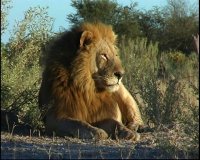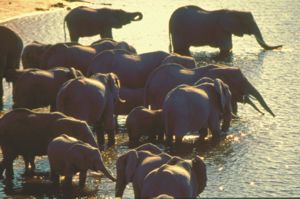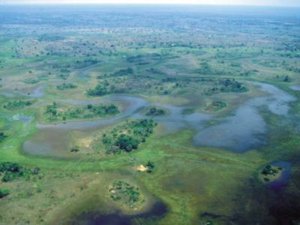THE OKAVANGO DELTA
The best known tourist destination in Botswana and one of Africa’s Special Places. The 15 00 Km² Delta, a mosaic of channels, lagoons, dry and inundated floodplains, papyrus, reeds and exotically vegetated islands have been declared a World Heritage Site. It is unique, the world’s largest and wildest inland Delta, formed by a major river – the Okavango – that has its source over a thousand kilometers away. A river that looses itself in the Kalahari sands to the south, and never joins another river or makes it to the sea.
The beauty of the Delta is legendary: this is one of Africa’s most enchanting places, a huge oasis set in the desert.
For sheer seductive beauty, encompassing 20% of the Okavango Delta, clear flowing channels, lagoons, floodplains, grassland and vast forests, Moremi comes up tops – anywhere in the Africa. This is a real gem of a Park, with wonderful viewing of a whole range of big game species: lion, leopard, cheetah, wild dog, giraffe, many antelope species, buffalo, hippo to name but a few. Small mammals and birds abound.
This northernmost Park, covering nearly 11 000 Km² , has unrivalled game concentrations, especially along the Chobe River Front in the drier months of the year, though the general game can be seen throughout the year. This is elephant country par excellence, with some 45 000 elephants and Africa’s biggest herds: from June to the first rains – usually in November. Breeding herds of 200+ may be seen in the vicinity of the river.
The area is famous, too, for its pride of lions, herds of Cape buffalo, hippos, crocodiles, giraffes, and varied antelope species and for supporting the country’s richest bird life. The only place in Southern Africa where the Puku antelope occurs is along the northern stretches of the Chobe River. Game drives are highly productive and a boat, especially in the late afternoon, is a must. There is no better game viewing by boat anywhere in the world than along the Chobe River in the dry season.




MAUN
GABORONE
Savuti
Chobe River
Okavango
Delta
Makgadikgadi
Salt Pans
South Africa
Zimbabwe
Namibia
Okavango Delta - one of the last African wild places,
Savuti - part of the Chobe National Park, place of lions,
Chobe River - fantastic game in a scenic river front,
Makgadikgadi - salt pans desert, baobab trees,
Central Kalahari - spectacular desert wildlife, open
Where in Botswana are those places?
Central
Kalahari

Africa Safaris - Botswana - Wildlife Safaris & Cultural Tours
SAFARIS & MAIN DESTINATIONS IN BOTSWANA
Main destinations in Botswana:
All rights reserved. Copyrights - Pius Tebele.
There are several different kinds of safaris on offer. Please, familiarise yourself with them on separate pages dedicated to them. Click on the following button-links:
Moremi
B O T S W A N A
The Okavango Delta is a favorite destination of travelers wanting pristine wilderness and a variety of experiences. Depending on the location and camp/lodge chosen, these includes 4 x 4 game drives, motor-boat rides, mokoro excursions (canoes poled by a local guide), fishing, walking on Islands, elephant – back riding, bird watching, simply relaxing and soaking in the enchantment of the place. Most camps and lodges in the Delta are accessed by light aircraft and those in the periphery can be accessed by vehicles as well.
There is the remarkable phenomenon of the annual floods in the Okavango Delta. The new floodwater from Angola arrives in the northern ‘Pan Handle’ section of the Delta around November (peaking in February or March), reaches the central part around April/May (peaking June/July) and arrives in Maun late July. More than 95% of the Okavango Delta’s water evaporates before it reaches Maun.
The Delta supports, amongst other animals, the large cats (lion, leopard, cheetah), a variety of antelopes (including the specialist floodplain dwelling Red Lechwe), zebra, giraffe, buffalo, warthog, hippo, crocodiles and , increasingly, elephants. The Delta is the last great refuge of one of the shiest and most aquatic of all antelopes, the seldom seen sitatunga. These antelopes spend much of the day partly submerged in water where they eat aquatic vegetation. They are able to swim with just their nostrils protruding above the water level and hide up in papyrus and reeds. They are more prevalent in the central and northern parts of the Delta, but are nowhere common.
The Okavango Delta is renowned for its bird life and is a Mecca for birdwatchers. Some 450 species have been recorded in the Delta. The birding is at its best from November to march when migratory species descend there from the northern hemisphere. The peak breeding time is October to December. Species of special interest include:
Pink-backed Pelican, Goliath Heron, Slaty Egret, White-backed Night-Heron, African Spoonbill, African Pygmy Goose (world’s smallest duck), Lappet-faced Vulture, African Secretary Bird, Western Banded Snake-Eagle, Hobby, Striped Crake, Lesser Jacana, Wattled Crane, Long-toed Lapwing, Greater Painted Snipe, African Skimmer, African Mourning Dove, Coppery-tailed Coucal, Pel’s Fishing Owl, Giant Kingfisher, Carmine Bee-eater, Southern Ground Hornbill, Bradfield’s Hornbill, African Golden Oriole, Black-faced Babbler, Greater Swamp Warbler, Chirping Cisticola, Rosy-throated Longclaw, Swamp Boubou, Paradise Flycatcher, Brown Firefinch.

No two floods are ever the same. The flooding is a slow, steady and gentle process.
This Garden of Eden is noted for its variety of wildlife which may be viewed by boat, mokoro, on foot, on horseback, or even from the back of an elephant.
MOREMI GAME RESERVE
The center of game viewing activities is at Xakanaxa in the west side of the mainland section of the Reserve, and at Khwai in the northeast. This Reserve is a favorite to many people. Being relatively small (4872 Km² )it is easy to assimilate. Boat trips along the Okavango Delta’s waterways can be undertaken from Xakanaxa and are highly rewarding.
CHOBE NATIONAL PARK
Savute further south in the Park is untamed and dry except for a few weeks following the rains when the khaki-coloured bush turns to emerald green, attracting zebras and, inevitably the lions which prey on them. Rich in wildlife, Savute has wide open plains that were once a marsh. This area is well known for its highly successful hyena population. In the remote west of the Park is the Linyanti area, also game rich, and deep in the interior is the less frequented Nogatsha area where one is surprise to see another vehicle.